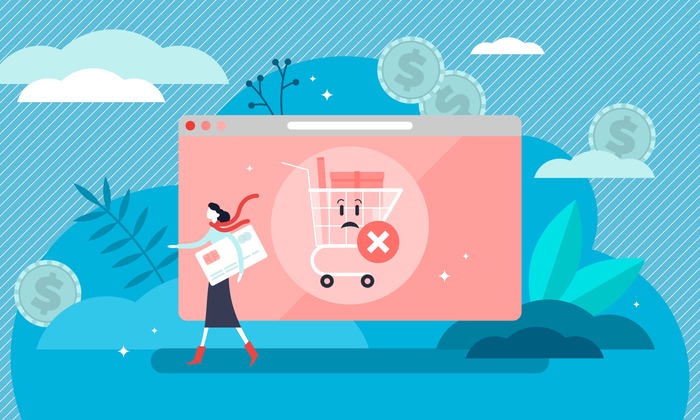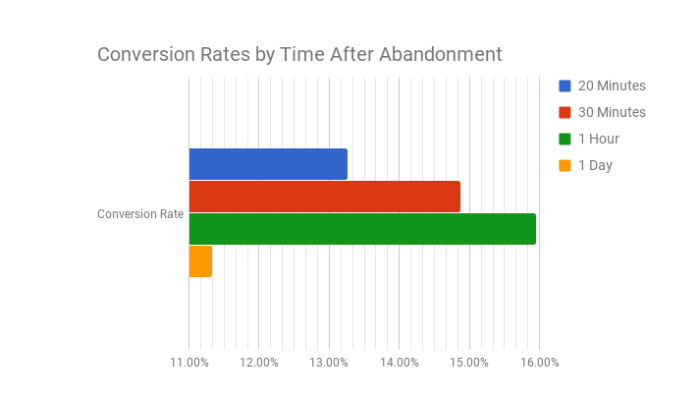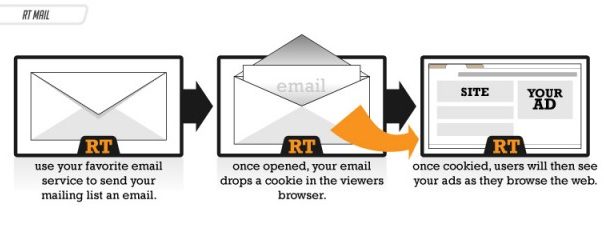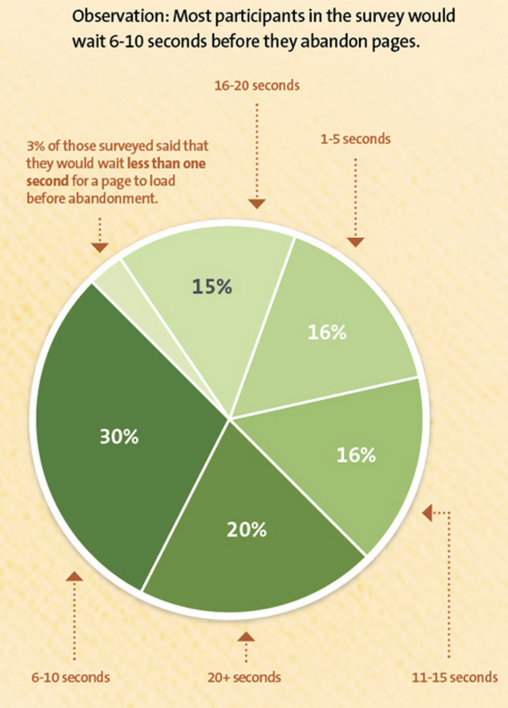
Shopping cart abandonment is big, bad, and pervasive. Baymard’s latest stats peg the average documented online shopping cart abandonment rate at a scary 69%.
That means for every ten e-commerce customers that put an item in their cart, nearly seven will leave the site without completing their purchase.
Shopping cart abandonment sucks, and it’s time to lower it.
The problem seems to get worse every year. It’s time to take back those sales and lower cart abandonment. But how do you reduce the effects of shopping cart abandoment?
Here’s 30 strategies to win those customers back and grow your bottom line.
1. Use Email Retargeting
If you want to slay cart abandonment, you need to get on board with email retargeting. Retargeting uses cookies embedded in email messages to display your ads to the user as she browses the web.
Retargeting is the perfect way to win back customers quickly after their abandonment.
2. Get Clear on Extra Costs
The top reason that customers give for abandonment is extra costs.
The easiest way to solve this problem? Get rid of those extra costs — or at least be clear about them.
If you absolutely must add in shipping charges, taxes, or other fees, be upfrong. As early as possible in the process, give them complete information regarding all the extra costs that they will see as they enter the shopping cart.
3. Provide Full Disclosure on Shipping Details
Shipping costs are another big kibosh for shopping carts.
In an age of Amazon Prime and holiday specials, customers have been trained to demand free shipping on just about everything. Chances are, you have some competitors that are winning because they have free shipping and you don’t.
If you can afford free shipping, great. If you can’t afford free shipping, then be sure to tell the customer everything about the shipping cost.
If necessary, provide a built-in calculator to determine estimated costs based on the weight and quantity of items.
4. Send an Email Immediately After the Customer Abandons
When an e-commerce customer abandons their cart, you have a few hours to reel them back in. Assuming that you’re using some retargeting technology and email marketing, send an email immediately.
According to Rejoiner’s data, here’s how likely a customer is to purchase after receiving a reminder:

Those first few hours post abandonment are the golden window of opportunity to regain lost customers. Capitalize on it.
5. Get Rid of Sign-In Barriers
Are you preventing customers from buying with sign-in barriers? Just don’t.
Forcing users to create an account may work for some products and services, but in most cases, you’re simply setting yourself up for disappointment. A great alternative to clunky sign-up processes is using social login.
6. Make the Check-Out Process 3-5 Steps
The more complicated your e-commerce checkout process, the less likely users are to complete it. The check-out process should be between three and five steps. The shorter, the better.
If you do try to shorten the process, make sure you’re not using too many fields in a single step.
7. Give the Customer Clear Progress Indications
It will help the customer if you can show them how far along in the process they are with a progress bar. Users like to have a feeling of progress and forward momentum as they reach for the goal of purchasing an item.
8. Use Simple and Prominent Calls to Action in the Shopping Cart
Every marketer knows the importance of calls to action. Are you using CTAs in your shopping cart, too? They are as important as ever.
Users want to know what to do next, and it’s up to you to tell them what to do.
Create a headline-style set of instructions for each phase of the checkout process. For example, tell the user “Where should we send your stuff? Please fill out your address.”
9. Add a “Save For Later” Button
Many shoppers abandon their carts because they’re using them as a wishlist or a place to save things they want to buy later. Instead of funneling them into a shopping cart, make it easy for them to create a wishlist with an easy option to buy later.
You get the benefit of lowered abandonment rates, and they get the upside of a wishlist that will easily funnel them into a later sale.
10. Talk to the Customer During the Process
Make the shopping experience conversational and interactive. There’s no need to be harsh and form-driven. Talk to them.
Brief and casual messages like, “Okay, we’re almost done.” and “We just need a little extra info here.” make the experience more enjoyable. I don’t know many people who love filling out forms, but if you make it less agonizing for the shopper, you’re more likely to gain their completion.
11. Don’t Throw in Extra Links
Avoid placing links that take the customer away from the shopping cart. The customer might leave the cart of their own volition, but don’t make it easy for them!
One of the common ways that e-commerce retailers lose customers is by trying to upsell with related products. Often, when a customer clicks on these products, they never return to the shopping cart.
12. Create Engaging and Powerful Product Pages
We obsess over shopping cart abandonment but consider what comes prior to putting something in a shopping cart — the product page.
Take a look at your product page. How engaging is it, really? Russ Henneberry recommends creating “high-quality, interactive product images.”
13. Create Continuity Between the Product Page, and Shopping Cart
If possible, display a thumbnail of the image in the shopping cart. The customer wants to make sure that they are actually purchasing the item that they selected. Making the cart items visible and visual is a great way to keep the customer moving through to completion.
14. Create One-Click Shopping
Amazon has probably made billions off of its one-click shopping button. It’s so easy to just click and buy without even deliberating over the pros and cons of the purchase.
You can steal a page from Amazon’s playbook by creating your own easy-to-buy shopping cart process. It won’t work for unregistered customers, of course, but it can work for members.
15. Avoid Surprises of Any Kind
According to CPC Strategy “Bad surprises are one of the most common contributors to shopping cart abandonment.” Don’t surprise your shoppers, whatever you do.
The shopping process can be a nerve-racking experience for some e-commerce shoppers. The customer’s mind is tense. They’re pulling out their credit card. They’re a bit nervous. What’s going to happen?
Then — BOOM! A confusing pop-up. A discount code request. An “error” message. A missing field. Whatever.
The checkout process goes up in flames. You surprised them (or they surprised themselves) and you lost.
Watch carefully for any “surprises” in your checkout process. Make it clear, deliberate, and completely free of pop-ups, unexpected messages, and other factors that could be seen as an interruption.
16. Boost Site Speed
If your site is slow, customers will leave.
The shopping cart is one of the most critical places to boost site speed. Site speed and conversions are tightly correlated. Faster websites are just plain better.
17. Get an SSL Certificate
SSL certificates make customers feel secure. In today’s web, SSL is considered a standard part of good design and development. (It’s also good for your Google ranking!) If your site, and especially your checkout process lacks security measures, you’ll scare some customers away.
18. Display Business Contact Information Prominently
Another way of enhancing the trustworthiness of your website is by adding contact information. Many online businesses display their NAP (name, address, phone number) in the site footer. This is merely one more way of giving your customers the assurance that you are a legitimate and reliable business.
19. Add Chat or Phone Support Options on the Checkout Page
If a customer has a problem, question, or issue with checkout, what are they going to do? In the absence of support options, they might just leave.
To prevent this from happening, add an 800-number or online chat support to the checkout process.
20. Make the Cart Easy to Edit
Your cart should be easy to change. Deleting items, changing quantities, and adjusting shipping options should be intuitive and simple. Don’t make the mistake of creating cryptic buttons that accidentally remove everything in the cart.
21. Show Security Symbols on the Checkout Page
Your checkout page is the place to pile on the security. Obviously, you don’t want to clutter up the page with too many of these, but a few well-placed badges can reassure the skittish customer.
22. Highlight Your Return Policy
Have you ever experienced buyer’s remorse? Some buyers do. Buyer’s remorse doesn’t just happen after a purchase. The anticipation of remorse can sometimes cripple buyers before they purchase.
To prevent this from happening, give customers a clear and easy understanding of your return policy. Make it simple. “Don’t like it? Just return it, on us. No questions asked.”
23. Limit Cross-Selling on the Checkout Page
Trying to cross-sell or upsell customers in the 11th hour may just contribute to shopping cart abandonment, not bigger buys. Keep cross-selling to product page and let the check out page focus on converting.
24. Add Testimonials Everywhere
Some people put testimonials only on a devoted page. I suggest putting them everywhere — even in your checkout process. A simple callout or sidebar with a customer recommendation or two can keep the motivation level high as the customer continues to check out.
25. Personally Review the Checkout Process At Least Once a Month
Do you have first-hand experience with your site’s shopping cart? Do you know what customers are experiencing as they proceed through the funnel, fill out each form, and complete each field?
Personally take the time to test your own shopping cart. As you continually test, refine, and edit your shopping cart process, you’ll be able to iron out wrinkles that may be contributing to abandonment.
26. Be Careful With Coupon Codes
Coupon codes are a double-edged sword. On the one hand, they may motivate customers to purchase. On the other hand, they could prevent customers from completing the transaction.
If a customer doesn’t have a coupon code, for instance, they may leave the site to look for one, but never return.
27. Make Shipping Times as Quick as Possible
Many online customers want their order to arrive as soon as possible. Make arrangements for expedited shipping if customers want it.
28. Provide Courteous and Helpful Error Messages
If a user gets frustrated with the checkout process, they are likely to quit. As you optimize your checkout process, create error notifications that are as helpful and direct as possible. There are two angles to this:
- Make it easy for them to find the error on the form.
- Make it easy for them to fix the error.
29. Accept Any Currency
If you offer international sales, make sure you are providing clear currency conversion information as well as acceptance of other currencies.
30. Allow Multiple Payment Methods
As e-commerce shopping has become more popular, there has also been an expansion of payment methods. Open the gates as wide as possible and allow buyers to use any credit card, Paypal, Amazon, or any other forms of payment that are common within your niche.
If you need more ideas to lower cart abandonment, try these three strategies.
Conclusion
The effects of shopping cart abandonment can kill your e-commerce bottom line.
As eager as you are to reel users back in, let’s be honest. There’s no such thing as 0% abandonment. Some e-commerce customers will abandon their carts, and you’re going to have to accept it.
Don’t use it as an excuse to keep you from fighting for as many conversions as possible. You’re going to win some back, and it’s worth the effort.
If you are struggling to drive traffic to your store, let us help.
How have you reduced your shopping cart abandonment rates?
The post 30 Strategies to Reduce Shopping Cart Abandonment & Drive Profits appeared first on Neil Patel.



